Chris Hardwick's Blog, page 2041
June 19, 2017
Funko Rolls Out a New Line of HARRY POTTER Pops! for SDCC
If you’ve been faithfully collecting every Harry Potter Funko Pop! figure so far, you might have to work a little harder this year. The latest batch of Potter Pops! will be a limited-edition SDCC exclusive set of three brand-new figures. It includes two variations on characters from the original series and a super-sized 6″ creature from Fantastic Beasts and Where to Find Them.
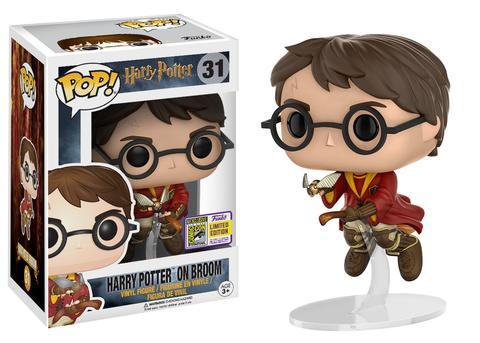
We’ve seen other iterations of Harry before. This time, though, he doesn’t look like your average Pop! figure. Instead, he’s sitting astride his Firebolt, sporting his Quidditch robes with a Golden Snitch on hand. The curved stand makes it an ideal figure for display and prevents tipping, a problem older toys in the Pop! line are prone to. (Newer models sometimes come with stands as well, though never quite so stylized as this one.)
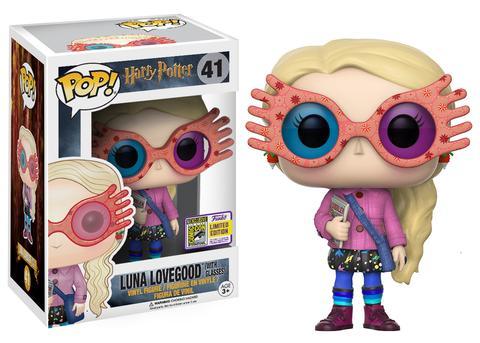
This isn’t the first Luna Lovegood we’ve seen, either. However, this is the first alternate outfit, and it’s a good one: Luna’s ensemble from the Hogwarts Express scene in Harry Potter and the Half Blood Prince, complete with Spectrespecs. She even has an issue of The Quibbler under her arm.

The Occamy, the sort of bird/serpent hybrid that radically shifted size throughout Fantastic Beasts and Where to Find Them, rounds out the group. Given the frequency with which its size shifted to humongous, it makes sense that this is a double-size Pop! measuring 6″ high. It also makes sense that Funko is churning out more Fantastic Beasts figures, given the impending sequels. The Occamy figure joins the likenesses of the Niffler, the Demiguise, and many of the movie’s human characters.
Which SDCC exclusives are you snapping up? Let us know in the comments!
Images: Funko
Bad Robot’s New Movie OVERLORD Coming in 2018
If there’s anything we’ve learned in the last several years, it’s that if a movie comes out from J.J. Abrams‘ Bad Robot Productions that we don’t know what it is, we need to sit up and take notice. On top of producing the Mission: Impossible and Star Trek reboot films—not to mention The Force Awakens—their two Cloverfield movies have become low-key favorites in the sci-fi thriller field, and this year’s God Particle will keep that going. Now you can add a movie called Overlord to their roster of movies that make us go “Uhhh…what? Cool!”
An announcement from Paramount on Monday detailed the next Bad Robot movie, slated for release in October of 2018. Right now it doesn’t have a whole lot to go on other than the logline which says “Set on the eve of D-Day, a group of American paratroopers are dropped behind enemy lines to carry out a mission crucial to the invasion’s success. But as they approach their target, they begin to realize there is more going on in this Nazi-occupied village than a simple military operation.”
So that could mean literally anything. It could be a straight-up WWII thriller or could be maybe an occult take on what the Nazis have done in that village, or maybe like a Lovecraftian thingamabob. We truly cannot say, but it does have a cast in place (the most notable members seem to be Iain de Caestecker from Agents of S.H.I.E.L.D. and Bokeem Woodbine from Fargo season 2), and it’s being directed by Julius Avery (Son of a Gun) with a script by Billy Ray (Captain Phillips) and Mark L. Smith (The Revenant), from an original idea by Ray and Abrams. So, you know, pretty deese all around there.
What do you think this movie could be about? Should it involve space aliens in some way? Let us know in the comments below!
Image Credit: Bad Robot
New WONDER WOMAN Story Arc Will Introduce Her Long Lost Brother
With Wonder Woman‘s regular monthly comic series losing the creative team of Greg Rucka, Nicola Scott, and Liam Sharp after one year, the series is still looking for a regular creative team. Writer Shea Fontana, is taking over for a small story arc soon, and then in September, DC Comics has announced that this fall—with Wonder Woman #31—a new creative team comprised of writer James Robinson (Starman, Earth-2), Carlo Pagulayan (Deathstroke), and Emanuela Lupacchino (Supergirl) and will begin a six-month run on DC’s main Wonder Woman twice-monthly comic book series with a new story arc, “Children of the Gods.” And it is said to focus on Diana’s mysterious…lost brother?
According to the official description coming from DC, the six month run will be spinning out of the pages of last year’s Geoff Johns’ oversized DC Universe: Rebirth Special and Justice League: Darkseid War, and Robinson, Pagulayan and Lupacchino will answer one of the biggest questions posed by the Rebirth Special: Who is Wonder Woman’s twin brother? DC describes the story as the following:
“Taken away from Themyscira in the dead of night, the mysterious Jason (the only male ever born on the island) has been hidden somewhere far from the sight of gods and men…but his life and Wonder Woman’s are about to intersect in a terrifying way, bringing them face-to-face with a cosmic threat they never imagined!”
Wonder Woman #31 is set to arrive in stores September 27. Below you can get a first look at Justice League artist Bryan Hitch’s cover for issue #31 featuring Wonder Woman herself, Darkseid’s half Amazon daughter Grail, and one of William Moulton Marston’s original Wonder Woman villains from the 1940s, Giganta, making her Rebirth debut. Fans can also expect variant covers by artist Jenny Frison. You can see Hitch’s cover for issue #31 below:
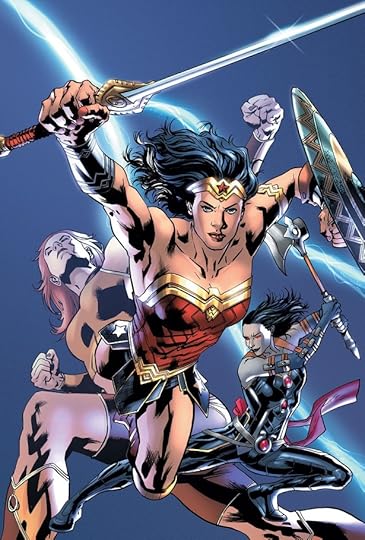
While this story may indeed be interesting (I don’t want to condemn anything too much without having read a page of it), the idea of Wonder Woman having a long lost male sibling feels like yet another example of DC trying to force more men into Diana’s family and origin story. This has been going on since the DC Universe relaunched in 2011 with the New 52 when Brian Azzarello began writing Wonder Woman. In the original William Moulton Marston concept, Diana was formed from clay and given life by the Goddesses. This origin was tweaked somewhat over the years—mostly by George Perez—but the basics more or less remained the same.

Then, with the advent of the New 52, it’s discovered that Diana’s clay origin was a lie, one created by Queen Hippolyta to cover up the fact that her daughter is the result of an affair with Zeus—an affair that must be covered up so Zeus’ wife Hera doesn’t kill the child in a jealous rage. We were then introduced to several half siblings of Wonder Woman’s (almost all men) while her fellow Amazons were turned into snakes. Azzarello wanted more dudes in the story, because heaven knows there aren’t about a million other male superheroes who are all about the dudes and their patriarchal influences. Geoff Johns’ Darkseid War arc brought in another Amazon/God Hybrid with Grail, the daughter of an Amazon and the God of Evil, Darkseid.

Then Rebirth happened, and it seemed Greg Rucka retconned the New 52/Azzarello run on Wonder Woman, including her being the result of an affair between Hippolyta and Zeus. The Azzarello Amazons (who were, frankly, awful man-hating murderers) were explained away as a delusion to keep Diana from trying to find the real Themyscira. But if all of that was a delusion, then how does she have a twin brother? And how is Grail even a thing, if those Amazons were merely a delusion? While Rebirth has tightened up a lot of DC Continuity, at the moment, Wonder Woman’s is still something of a hot mess.

Here’s the thing though: Wonder Woman doesn’t need a bunch of male relatives to appeal to men. The Patty Jenkins-directed Wonder Woman movie didn’t include any “Manazons,” and although Zeus is still her father in the film, the way she was brought into the world remained vague. (Meaning: the focus was definitely not her father or half-brother Ares.) And yet, the film still managed to be a massive success, with women AND men flocking to see it again and again. The idea of needing to inject more men into her mythology feels like a desperate attempt to appeal to male sexism, and a perceived inability to connect to stories where women are front and center.
Hopefully when this is all said and done, Wonder Woman will once again not have a single male relative, and be the product of female Gods and and a powerful matriarchy. Sure, men need to be a part of her story, but part of the magic of Wonder Woman is that everything that made her who she is came without a Y chromosome. In the meantime, here’s hoping James Robinson can spin a compelling yarn and make all of this extra masculinity injected into Diana’s mythos worth it for readers.

What do you think of the former only child of Themyscira having a male sibling? Let us know down below in the comments.
Images: DC Comics
GIF: Warner Bros./Giphy
Could Sony’s SPIDER-MAN Spinoff Films Damage the MCU?
Poor Kevin Feige. Marvel Studios’ president was having such a good summer until now. Guardians of the Galaxy Vol. 2 was a huge hit, and Spider-Man: Homecoming looks like it’s going to bring the Wall-crawler back to box office supremacy. Even Sony’s off-brand Marvel movies with Venom, Silver Sable and Black Cat couldn’t bring Feige down. But one awkward interview later, Feige has become a meme to rival Sad Ben Affleck. Judging from the clip, it sure looks like Feige is just as surprised about Spider-Man’s involvement with those spinoff films as we are! What in the J. Jonah Jameson is happening here? Today’s Nerdist News is breaking it all down!
Join host and the third woman to be bitten by a radioactive spider, Jessica Chobot, as she walks us through the key moment in Feige’s co-interview with Amy Pascal to promote Spider-Man: Homecoming. It’s important to note that Spidey’s return to the MCU probably wouldn’t have happened without Pascal’s support, which is why she’s a producer on Homecoming even after she left Sony. Still, Pascal clearly went off script when she said “those [spinoff] movies will all take place in the world that we are now creating for Peter Parker. They’ll be adjuncts to it, it may be different locations but it will still all be in the same world, and they will be connected to each other as well.”
This is not impossible, but it is something that both Sony and Feige have previously denied. Unlike the deal that ties Spider-Man to Sony, there is an expiration set for the Marvel and Sony alliance. When that arrives, Sony and Marvel either have to make a new deal or Sony will once again get Spidey all to themselves. Unless there is a specific contract provision that says otherwise, Sony can put Tom Holland’s Spidey into their Venom or Silver and Black films. If Sony wants to force the issue or let Marvel’s current deal expire, then there’s nothing that would stop it from happening.
The concern is that Venom and Silver and Black will muck with the tone and continuity that have been so carefully crafted by Feige and Marvel Studios for the better part of a decade. It would be a much better alternative for Sony and Marvel to work together more closely on those projects, and the MCU could become an even deeper place with the introduction of two more heroines and an alien threat with personal ties to Spidey. Just opening the door to even more heroes and villains from that corner of the Marvel Universe would be an exciting development, however unlikely that seems at the moment. We believe that there’s still a possibility that Pascal is simply teasing an aspect of the Marvel and Sony deal that just hasn’t been announced yet. Here’s hoping the Spiderverse remains united with the MCU. That really would be the best solution.
What do you think about the possibility of Spider-Man appearing in the Sony spinoff films? Let’s discuss in the comment section below!
Get to Know GODZILLA: KING OF MONSTERS Classic Kaiju
For over 60 years, Godzilla has been wreaking havoc and saving humanity as the crown jewel of Toho’s iconic monster movies. Starring in 29 of the studio’s beloved features, Godzilla is the oldest and longest running franchise in film history, beating even 007 himself. Hollywood has attempted to bring Godzilla to the screen with mixed results, “Americanizing” the Japanese films with new footage and dubbed dialogue since the 50s as well as the now notorious 1998 CGI monstrosity. In 2014 Warner Bros. rebooted the Godzilla legend with another self-titled blockbuster movie that leaned heavily into the the source material and was successful enough that the studio announced a Monsterverse franchise, that continued with this year’s Kong: Skull Island.

That film teased the arrival of some of Toho‘s biggest monsters, and now Warner Bros. has announced that filming is about to begin on their Monsterverse movie, Godzilla: King of Monsters, directed by Michael Dougherty and starring Ken Wantanbe, Millie Bobbie Brown, Vera Farmigera, and Sally Hawkins (not to be confused with Adam Wingard’s Godzilla film). Though the cast is great, the most exciting thing is the reveal that the new film will indeed be focused on Toho’s marvelous monster menagerie.
Kaiju fans will know that there’s so much more to the legend of Godzilla than just the titular titan, but just who are these captivating creatures? Where do they come from? How many times have they fought Godzilla before? Here’s a rundown of the new additions to WB’s Monster Island.
Rodan

A giant pteranodon, Rodan is one of the few Toho monsters who’s an actual dinosaur—in Japan, its name is Radon, a contraction of the dinosaur it was named after. It began life in Toho’s first color kaiju movie, Radon, Giant Monster of the Sky, before becoming a part of the larger Godzilla series. As Godzilla was conceived to represent the American atomic threat, Rodan was created to represent the Soviets’ budding nuclear power. Though its first appearance was just as a terrifying monster problem for the film’s scientists to solve, Rodan later took on a more heroic role in films such as Ghidorah, The Three-Headed Monster, where Rodan teams up with Godzilla to save Mothra and the world by defeating the three headed uber kaiju, Ghidorah. Starring in nine Toho films over a 50 year period, Rodan is one of the less prolific but no less recognisable kaiju, whose dinosaur origins make a lot of sense for the more prehistoric tone that Kong: Skull Island set for the franchise.
Mothra

Though many of the studio’s most famous creations cross the line between hero and villain–often saving the world rather than destroying it–Mothra is almost always painted as a protector and hero in Toho monster movies, whether it’s her own island, Japan, or the world. Usually accompanied by two fairies, Mothra is a unique addition to the Warner Bros. Monsterverse, but an unsurprising one. Mothra is largely recognized as the second most popular creature from the Toho kaiju movies and has starred 13 movies, coming second only to Godzilla in number of appearances. Her iconic design—a large moth or caterpillar depending on the incarnation—has made her a hit with kaiju fans around the world. Her massive popularity with female cinema goers in Japan, who were buying the majority of theater tickets at the time, led to the production of Godzilla vs. Mothra in 1993. If Warner Bros. sticks to her heroic roots and unique powerset, Mothra could be the unexpected hit of the Monsterverse.
King Ghidorah
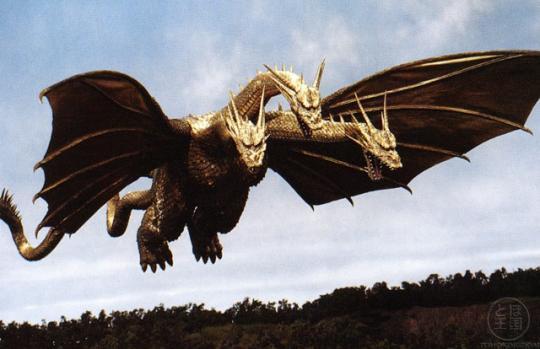
Arguably the coolest of Toho’s iconic monsters, King Ghidorah’s three-headed golden scaled visage is truly a sight to behold. The mortal enemy of Godzilla and Mothra—though there’s one instance where Mothra and Ghidorah are allied—this flying dragon has a number of origins, including his debut in 1964 as an extraterrestrial from “the gold planet,” Venus, hence its shiny skin tone. Inspired by a sketch of an ancient greek Lernaean Hydra and the Orochi of Japanese folklore, King Ghidorah is one of the most imposing foes Godzilla has ever faced. During the Shōwa era of Toho, Ghidorah was often an intergalactic pawn used by aliens trying to take over Earth. Later it would be reimagined as a futuristic monster created to stop Japan’s future economic dominance by an evil group who attempted to halt the creation of Godzilla so that Ghidorah could destroy Japan with no interference. Due to Ghidorah’s prominence as a solid villain throughout Toho monster history, it’s pretty likely that Godzilla may once again have to team up with Mothra and Rodan to beat this biggest of bads.
How do you feel about Hollywood finally tackling these iconic monsters? Are you excited to see them on the big screen? Or do you just wish they’d finally give Godzilla’s cute chubby son Minira his own feature? get in touch and let us know!
Images: Toho Studios
Web Series TOKYO NEIGHBOURS Explores Being Gay in Japan
Often the only LGBTQ narratives that we see are focused on the western and predominantly white experience of being queer, but a lovely new web series from Japan is here to change that. Tokyo Neighbors is a charming lo-fi short film series by Onabys Pictures and set in a Tokyo bar in Shinjuku’s Ni-Chome district, focusing on the lives of the bars’ inhabitants.
Delving into interpersonal relationships of this small group of gay men, Tokyo Neighbors is an intimate and authentic experience, with the first episode focusing on the everyday intricacies of dating and being in love as a gay man in Tokyo. The show is a refreshing spotlight on an often ignored segment of Japanese culture.
It has historically been hard to access Japan’s queer manga in any other form than fan-scans, but the publication of a translated collection of Gengoroh Tagame’s iconic gay erotic manga, The Passion of Gengoroh Tagame, began to change that in 2013. This year saw the English language release of Tagame’s gorgeous slice of life book, My Brother’s Husband, a moving look at the gay experience of living in Japan and the effects that culture and western influence have on being gay there. This year also saw the release of the heartbreakingly honest and beautiful My Lesbian Experience With Loneliness by Kabi Nagata, whose matter of fact style of discussing being a lesbian struggling with anxiety and depression has taken the internet and comics community by storm.
Tokyo Neighbors is a wonderful addition to the recent influx of queer storytelling from Japan, and is a great example of a well made and engaging web series. You can watch the first short film with English subtitles right now! And for those of you who speak Japanese, there are seven episodes for you to enjoy!
Images: Onabys Pictures
SPIDER-GWEN Gets Her Own Mondo Poster and Figure
Spider-Gwen first appeared in Edge of the Spiderverse #2 in an alternate Spidey universe in which New York’s friendly, neighborhood Spider-Hero wasn’t Peter Parker, but Gwen Stacy. The story was an intriguing move to turn a former flame of Peter Parker into a costumed hero, and it was one that most fans met with lots of love and excitement. Her inaugural appearance in the Marvel comics universe sold out incredibly quickly, and soon led to her own series. (Though referred to by the people of this version of the city as Spider-Woman, we know and love her as Spider-Gwen.)
To celebrate the awesome Spider-Gwen (and maybe encourage the Marvel to invite the Spidey Gwen Stacy to the MCU party? Wishful thinking, but mayyybee?), Mondo will be putting some impressive Spider-Gwen figures and posters on sale tomorrow (via Screen Rant).
Celebrating SPIDER-GWEN with an awesome new statue + posters! Details via @screenrant: https://t.co/2WaE8Wo1JW pic.twitter.com/tGhdb2RzNT
— MONDO (@MondoNews) June 19, 2017
There are two version of the Spider-Gwen figure. One is a mass released version of Spider-Gwen chilling on top of a building either snapping a selfie or slinging some web (your choice, her hands are interchangeable). The other figure is a Mondo exclusive which features her in the same place, but with an interchangeable head to feature her masked or unmasked!
Exclusive First Look: Mondo’s Spider-Gwen Statue and Poster – https://t.co/JjbWVtlFV2 pic.twitter.com/Le28SZIvf6
— Screen Rant (@screenrant) June 19, 2017
The posters also feature a widely-produced version and a Mondo variant. Illustrated by Rosemary Vallero-O’Connell, the posters have a pink tint and feature Spider-Gwen chilling on top of a theater (that happens to be advertising a show from Gwen’s band, The Mary Janes). Like the figure, you can snag a version of her masked or unmasked.
Did you see these Spider-Gwen posters by @hirosemaryhello for @MondoNews? https://t.co/BQLYcZZl5O pic.twitter.com/P5ulQmQn3r
— Rob Keyes (@rob_keyes) June 19, 2017
You can get a better look of the images back at ScreenRant, and be sure to head over to the Mondo site tomorrow when they officially go on sale! What do you think of the figure and the posters? Do you like the masked or unmasked versions better? Tell us what you think in the comments!
Featured image: Marvel Comics
June 18, 2017
Orlando Jones Explains Why AMERICAN GODS’ Mr. Wednesday Needs a Queen
The growth of America as a country has moments of inspiration, brilliance, and ingenuity; it’s often glorified with stories of miraculous opportunities. Those stories have played out. They one hundred percent exist. But for some, the evolution of America is also a tale of being pushed aside and silenced. It’s a narrative playing out in American Gods, from a certain point of view. Mr. Nancy, a.k.a. Anansi, put the spotlight on Bilquis–a character who has stood proudly back up after being beat down by the world–in the season one finale of the show. Bilquis, Orlando Jones told Nerdist, shouldn’t be overlooked.
Anansi tapped into his storytelling roots and tried to teach a lesson to Mr. Wednesday. In talking about his performance in presenting Bilquis‘ journey, Jones said, “It was important for me to remember, and I think for Nancy, to impart that there has never been a war in human history that has ever been won without the support of women.”
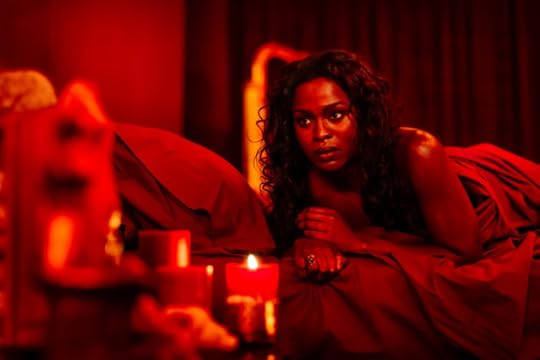
And Bilquis, their Queen, has survived and evolved after being let down again and again. The Old Gods didn’t protect their queen; they haven’t looked out for their own and allowed her to fall. It’s not an issue Wednesday necessarily recognizes as he recruits allies. With his story, Nancy told Wednesday there needs to be compromise but also that Wednesday should open his damn eyes. “He’s pointing out to Wednesday that there is compromise, but there’s also this role of these people who are often diminished, and that’s as important as these other people that we celebrate,” Jones said about Nancy’s tale.
Nancy is using his stories to speak up. “He’s attempting to always be the voice of the disenfranchised, because frankly, you meet him on a slave ship amongst the other disenfranchised,” Jones said, “When you’re talking about American history you talk about gender roles, and ageism, and race, and sex–all of these things come together to create a truly powerful force of people and individuals who have a lot of information to impart, but we consistently say that isn’t important as we watch bodies of men make decisions on behalf of everyone, as if they don’t have an opinion or that they don’t have anything to bring to the table because they couldn’t possibly understand how intricate things are. I think he’s saying that, really, to Wednesday.”

Jones pointed out how Wednesday’s not been looking outside his own narrow view. Wednesday’s been trying to stack his deck with as many Old Gods as possible, but he hasn’t gone to likes of Bilquis. “He didn’t go to Bilquis that way. He’s actively been trying to put Laura Moon back into her grave. He’s consistently seeing the world in a very specific way that is quite male-centric,” Jones explained, “Nancy’s trying to point out, ‘That’s not the way we’re gonna win this war, and also that there has to be some level of compromise in what we do moving forward.’ For him, if that doesn’t exist for those parties then it’s not going to exist for him either.”
Nancy appears to be on Wednesday’s side for now, but the Old God looks out for himself, too. As a keeper of tales, words are his gift. He wields them the way he must to keep going. He needs worship; he has to have believers in order to exist. That drives his agenda and keeps him playing the game. “I think Nancy’s always playing both ends against the middle a bit, but he often uses the truth of his words to make his point and to get people on his side,” Jones said.
More of Nancy and his stories will be ahead in the second season of American Gods. Jones shared the character will have a bigger role to play: “I’m super excited about season two where Nancy will be very, very heavy.”
Images: Starz
AMERICAN GODS History Primer: Easter, a.k.a. Ostara
The Old Gods in American Gods have roots in the past and in mythology. While we might know the ins and outs of the New Gods, like Media and Technical Boy, there’s probably a lot we can still learn about their predecessors. For those of you hoping to get a better understanding of these characters before you continue on with American Gods, we have you covered. Get to know the history that inspires the characters in our American Gods History Primer series.
Who
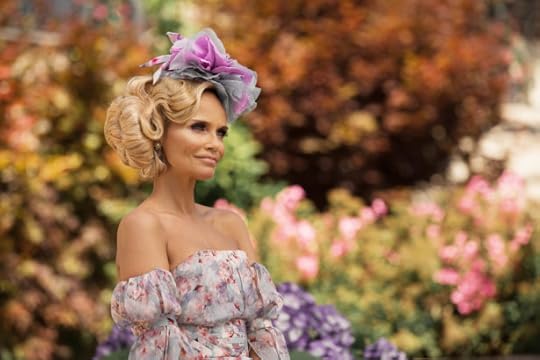
Easter, a.k.a. Ostara, a.k.a. Eostre
In the Series

The name of the game for many of the Old Gods is compromise. They’ve been brought to American and left behind, so they have to do what they can to keep going. It could mean bending alliances, playing both sides, or soaking up belief from a holiday named after you, but at the same time, having nothing to do with you. That’s where we met Easter. And you know what? I don’t judge her, and neither should you. Easter has found a way to make things work. She’s found a way to not only survive, but to flourish. I respect her.
Easter has thrown whole hog into the modern celebration of the holiday, complete with honey ham, chocolates, and flowers. People celebrate in the name of Easter, and she can feed off their energy. Most of them wouldn’t recognize the name “Ostara,” but Easter doesn’t see it as an insult. She also welcomes multiple representations of Jesus into her home as a compromise (see, it’s important). She’s gamed the system, but it’s meant holding back. Mr. Wednesday cajoled Easter into letting loose and showing the world what’s she’s capable of, and to say it was a mix of awe-inspiring and terrifying would be an understatement.
Easter planted a flag, and by doing so, she’s forcing oblivious humans to take notice.
In Mythology
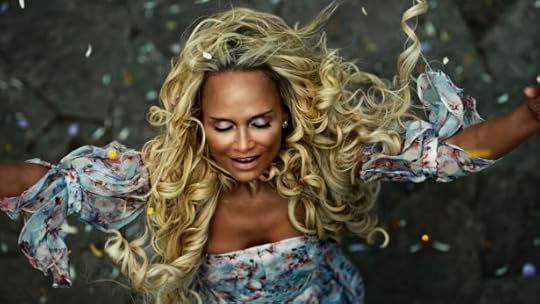
Ostara can be found in Germanic mythology as the Saxon goddess of the spring. It was her responsibility to bring the spring each year. She’s associated with the rising sun and also fertility (I’m sure you’re already imagining a connection to bunnies). Spring is a time of birth, creation, light, and growth. Ostara, also called Eostre, represented all those things.
Eostre had a festival of her own on the Spring Equinox. It will not surprise you to learn Eostre was associated with a rabbit. As she was the spring goddess of fertility, an egg was her symbol. These ties are one explanation for how bunnies and eggs became connected to modern Easter activities. However, not much was documented about Eostre, and it’s possible she was an invention of the scholarly monk Venerable Bede (Jacob Grimm of the Grimm brothers believed Bede and somewhat validated the story by referencing Ostara in his work).

Another story featuring the goddess Ostara offers a different reason for bunnies coming to the party–and this tale, like all myths, has altered over the years like a game of telephone. The most commonly referenced version says she arrived late to the party with spring and found a bird dying because of the cold. Ostara felt guilty and cared for the bird (some iterations say she took the bird as a lover). Then, she turned the bird into a rabbit and granted him the ability to lay colored eggs one day of the year. Those rainbow-hued eggs have become a key aspect of the holiday.
There’s little historical documentation for Eostre or Ostara, so like all things with the Old Gods, it’s a matter of what you believe.
Images: Starz
The Dawn of Ostara, and Other Moments in the AMERICAN GODS Season Finale Explained
Spoilers for the season finale of American Gods follow! You have been warned.
Well, that episode of American Gods was certainly unexpected! I’m sure the other book fans out there can vouch for this, but I had assumed the end of this season would end somewhere completely differently than Easter’s Kentucky home. Still, there were a lot of juicy details to dig during this season finale, so let’s get right into it:
Coming To America, Bilquis Edition
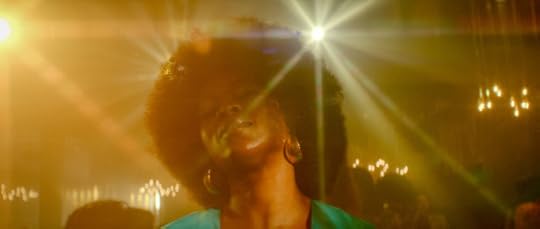
So far most Coming to America stories are told by Ibis, but this one required the bolder hand of Mr. Nancy, whom we haven’t really seen since his own journey to the States (or near them, before the slave ship went down) in the second episode. While Shadow and Wednesday are at his shop getting new suits made, he lets them in on a secret: Bilquis has joined up with the New Gods, too. In hindsight it should have been obvious given how much she relies on dating apps to secure her sacrifices.
Her journey, as you might imagine, was not a pleasant one. Long ago—864 BC, to be precise—Bilquis partied it up regularly in the Temple Of Ba’ran, which was a real temple in Yemen (although its ruins are more commonly known as the Temple of Marib now, so named for the capital of Sheba). By 1979 she’d moved out of the Arabian peninsula and into Tehran, Iran, but was forced to flee from the Iranian Revolution, which represented a return to conservative social and religious values that would have severely limited Bilquis’ ability to reign.
She survived, but was relegated to the “back seat,” in Nancy’s words; by the time Technical Boy comes across her in 2013 she’s living on the streets, and her temple back in Yemen has been destroyed by ISIS (As far as I know this has not happened, although a suicide bomber targeted the temple in 2007, and ISIS has targeted similar ancient temples in Syria). No wonder she’s so willing to use the lifeline the New Gods have given her, even if it means compromising her morals and putting herself on the wrong side of the battle.
Back To The Bone Zone
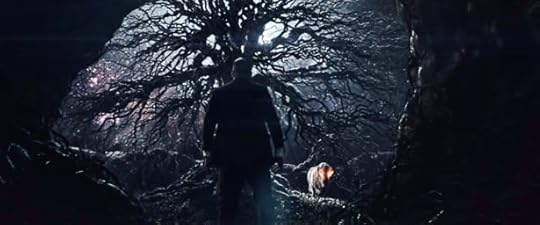
Shadow has another dream about the White Buffalo in the Bone Orchard, which this time looks less like an orchard and more like a giant wall o’ skulls to climb up. Remember, we’ve seen this tableau before in Episode 1, and in Episode 6 when Atsula of the Nunyunnini glimpsed it for herself. And we can’t forget the World Tree at the top; now that it’s been revealed that Mr. World might have come from such a tree, does its presence link him to Shadow’s subconscious? Or is it just a coincidence? Is there such a thing as a coincidence on this show? No, probably not.
Jesus is Everywhere
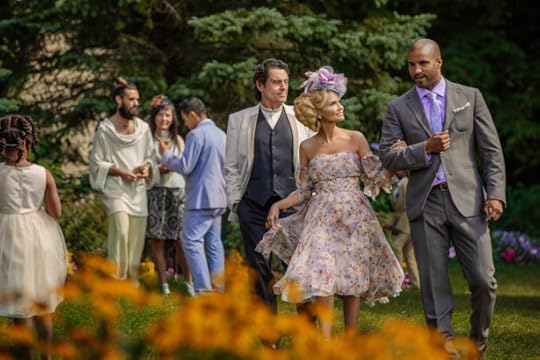
Shadow and Wednesday are now in pursuit of their own queen: Ostara (sometimes Eostre), a Germanic goddess whom most people around the world would know better as Easter. “But Victoria,” you’re probably saying if you didn’t actually watch the episode. “Isn’t Easter a Christian thing?” Well, it is now! Basically, every weird question you’ve ever had about why the Easter Bunny is a thing or what’s up with all the painted eggs can be explained by the fact that Easter was folded into Christianity from a completely different pagan spring festival.
When you grow up in a Christian household you’re usually taught that Jesus is omnipresent in your life, but I bet most people don’t picture it quite the way that Easter’s party plays out: with a different savior for every race and creed all hanging out together at one shindig. It’s nice to see the throughline of multiple Christs for multiple believers finally coming to a head, as it’s been referenced several times in the show now.
Son Of God
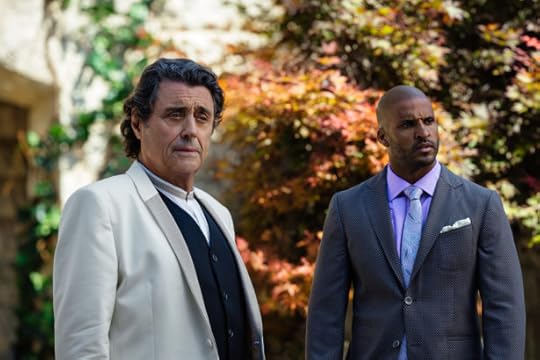
Naturally Wednesday is not particularly politically correct with the Jesuses and calls them out for ripping off Easter’s big day, and in the middle of all that he points out that they are sons of Gods, which means they are “men who walk the streets.” An interesting distinction, although it’s not entirely accurate for the way some Christians see Jesus (look up the Trinity; it’s a real trip).
But if you’re a book fan and you have an inkling as to why properly classifying a deity’s offspring might be important, it’s interesting to see the show planting those seeds already. And it also absolves Jesus from having to pick a side in the War, because he—or rather, they—don’t rely on prayer in quite the same way. As one Jesus tells Shadow later, “I am belief. I don’t know how not to believe.”
Laura’s Resurrection
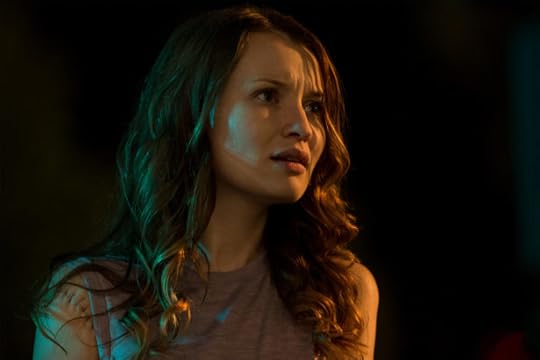
Finally, Sweeney and Laura show up to enlist the help of his resurrecting friend, who—surprise!—is Easter. She wants to help, but wouldn’t you know it, her power to “re-life” is limited by the fact that Laura was killed by a God. She figures this out by seeing the exact moment of death in Laura’s retinas, a real pseudoscientific practice called optography that was attempted in the 19th century. Remember that part of Wild Wild West where they use a man’s severed head as a projector? Same principle.
Unfortunately, this means that Laura’s going to keep being dead “of a different kind” for a while, and now she knows why: because Wednesday willed it, as a sacrifice to get to Shadow. He interfered with her plan to rob the casino, too, looks like. So now the big question is: what makes Shadow so important to Wednesday’s plan?
The Easter Parade Arrives
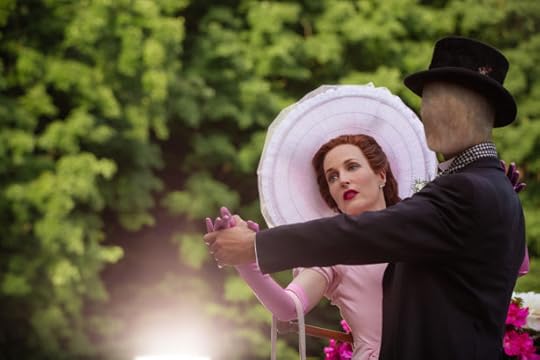
Of course, a party wouldn’t be complete without the New Gods! Media is wearing an Easter bonnet and gown loosely based on the one Judy Garland wears in the 1948 Easter Parade Musical by Irving Berlin; the first few lines she says to Easter are lyrics ripped right from the song. (her henchmen are also dressed as Fred Astaire). As she says to Easter, they have a standing date for a Marshmallow Peep Show, which is an annual tradition that regularly incorporates pop culture-inspired dioramas. It’s a threat as much as its a reminder; Ostara apparently made a deal with the New Gods too, just like Santa Claus did.
Wednesday interrupts, of course, calling the New Gods out as an “existential crisis diversion” rather than a true source of divine inspiration before he takes out a whole fleet of henchmen. And in doing so, he finally reveals his many true names: he is Odin the All-Father. His reckoning inspires Ostara to reveal her power too (plus a pretty incredible head of Pre-Raphaelite hair), and, taking a suggestion from Wednesday, she withholds the harvest and causes all the plant life for miles around to return to the ground.
House On The Rock
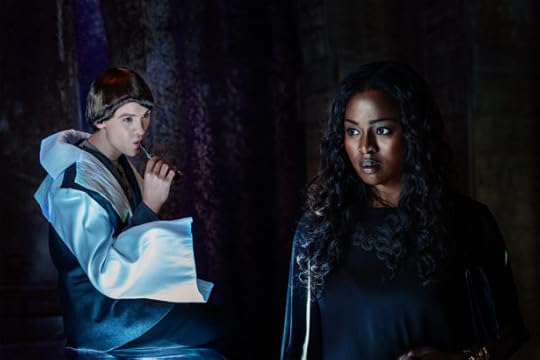
The episode ends with a first glimpse at what will become the meeting place for the Old Gods: The House On The Rock, a tourist attraction in Wisconsin that’s built on holy ground. Much as I wanted to actually look inside and finally see the thing, the show does hint that Bilquis will be there as Technical Boy’s god on the inside, which will put her right in the path of Shadow and Wednesday. Too bad that hanging thread won’t be resolved until next season?
All in all it was a solid, although I’ll admit that it felt somewhat anticlimactic for a season finale. What did you think? Have any more questions you need answered? Ask away in the comments!
Images: Starz
Chris Hardwick's Blog
- Chris Hardwick's profile
- 132 followers




